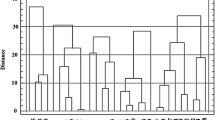Abstract
Between 1963 and 1976 a population of South American Andigena potatoes was subjected to six cycles of recurrent selection at Ithaca, N.Y. for adaptation to North Temperate conditions. This research was undertaken to measure the changes in adaptation and earliness that have taken place in the process of selection. Field experiments with different harvest dates and a controlled daylength experiment in the greenhouse in Ithaca showed: 1) an increase in percent tuberization, tuber weight and size, and harvest index; 2) no change in total fresh weight (haulm + tuber); and 3) a decrease in fresh weight of haulm. Greatest differences among cycles of selection were observed at the early harvest date. Tuberization on cuttings was well correlated with other measures of maturity. Cycles three and four, which were started from open-pollinated seed, tended to “revert” to the form of the original population in terms of late maturity (or low tuberization and yield at the early harvest date) and low harvest index. These results are interpreted as a gain in photoperiod adaptation and earliness with possible effects of mating system and selection pressure on the rate of progress.
Resumen
Entre 1963y 1976 se sometió una población de papas Andigena de Sud América a seis ciclos de selección recurrente por adaptación a las condiciones temperadas del hemisferio norte en Ithaca, Nueva York. Se emprendió esta investigación con el objeto de medir los cambios en adaptación y precocidad que hubieran tenido lugar durante el proceso de selección. Experimentos de campo con diferentes épocas de cosecha y un experimento de invernadero bajo condiciones de longitud de día controlados en Ithaca mostraron: 1) un incremento en el porcentaje de tuberización, peso y tamaño de tubérculos y en el índice de cosecha; 2) no se registró cambio en el peso fresco total (follaje + tubérculos); y 3) un decremento en el peso fresco del follaje. Las mayores diferencias entre ciclos de selección fueron observadas en las cosechas tempranas. La tuberización en esquejes estuvo bien correlacionada con otras medidas de maduración. Los ciclos 3 y 4, que fueron originados de semilla de polinización abierta, tendieron a “revertir” a la forma de población original en términos de maduración tardía (o baja tuberización y rendimiento en las cosechas tempranas) y bajo índice de cosecha. Estos resultados son interpretados como una ganancia en adaptación al fotoperíodo y en precocidad con posibles efectos del sistema de apareamiento y presión de selección en el grado de progreso conseguido.
Similar content being viewed by others
Literature Cited
Dennis, R.W.G. 1939. Notes on the photoperiodic reaction and virus contents of some Peruvian potatoes. Ann Appl Biol 26:87–101.
Driver, C.M. and J.G. Hawkes. 1943. Photoperiodism in the Potato Imperial Bureau of Plant Breeding and Genetics, Cambridge, England.
Ewing, E.E. 1978. Critical photoperiods for tuberization: a screening technique with potato cuttings. Am Potato J 55:43–52.
Glendinning, D.R. 1975. Neotuberosum: new potato breeding material. 2. A comparison of Neotuberosum with unselected Andigena and with Tuberosum. Potato Res 18:343–350.
Glendinning, D.R. 1976. Neotuberosum: new potato breeding material. 4. The breeding system of Neotuberosum and the structure and composition of the Neotuberosum gene pool. Potato Res 19:27–36.
Hackbarth, J. 1935. Versuche über photoperiodismus bei südamerikanischen Kartoffelklonen. Züchter 7:95–104.
Howard, H.W. 1962. Potato cytology and genetics 1952–1959. Bibliogr Genet 19:216.
Junges, W. 1976. Influence of day length upon clones of tetraploid cultivated potatoes from different South and Central American area of origin.In. Plant Breeding Abst 46:377.
Krantz, F.A. and A.E. Hutchins. 1929. Potato breeding methods. II. Selection in inbred lines. Minn Agric Expt Stn Tech Bull 59. 23 p.
Krauss, A. and H. Marshchner. 1976. Einfluss von Stickstoffernähoung und Wuchsstoffapplikation auf die Knolleninduktion bei Kartoffelpflanzen. Z Pflanzenernaehr Bodenk 139:143–155.
Lazin, M.B. 1980. Screening for heat tolerance and critical photoperiod in the potato,Solarium tuberosum (L.). Ph.D. Thesis, Cornell Univ.
Lazin, M.B., I.J. Sung, E.E. Ewing and J.B. Sieczka. 1979. Relation between maturity of varieties and critical photoperiod for tuberization as determined by the stem cutting techniques. (abs.) Am Potato J 56:166.
Mendoza, H.A. and F.L. Haynes. 1974. Inheritance of tuber initiation as influenced by photoperiod in the autotetraploidS. tuberosum L. groups Tuberosum and Andigena. Am Potato J 51:299.
Plaisted, R.L. 1972. Utilization of germplasm in breeding programs — use of cultivated tetraploids.In. Prospects for the Potato in the Developing World (E.R. French, ed.). Centro International de la Papa, La Molina, Peru.
Plaisted, R.L. 1974. A project to duplicate 400 years of potato evolution. IntAgric 1:24–26.
Plaisted, R.L., H.D. Thurston and W.M. Tingey. 1975. Five cycles of selection within a population ofS. tuberosum ssp.andigena. Am Potato J 52:280 (Abstract).
Simmonds, N.W. 1960. Variability and utilization of Andean potatoes. John Innes Inst. Ann Rept 51:33–34.
Simmonds, N.W. 1964. Studies of the tetraploid potatoes. I. The variability of the Andigena group. J Linn Soc Lond Bot 58:462–474.
Simmonds, N.W. 1966. Studies of the tetraploid potatoes. III. Progress in the experimental re-creation of the Tuberosum Group. J Linn Soc Lond Bot 59:279–288.
Author information
Authors and Affiliations
Additional information
Paper No. 699. Dept. of Plant Breeding and Biometry, Cornell University, Ithaca, NY 14853. This research was supported in part by the International Potato Center.
An erratum to this article is available at http://dx.doi.org/10.1007/BF02855379.
Rights and permissions
About this article
Cite this article
Rasco, E.T., Plaisted, R.L. & Ewing, E.E. Photoperiod response and earliness ofS. tuberosum ssp.andigena after six cycles of recurrent selection for adaptation to long days. American Potato Journal 57, 435–447 (1980). https://doi.org/10.1007/BF02854459
Received:
Published:
Issue Date:
DOI: https://doi.org/10.1007/BF02854459




